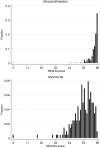Development of an easy-to-use Spanish Health Literacy test
- PMID: 16899014
- PMCID: PMC1797080
- DOI: 10.1111/j.1475-6773.2006.00532.x
Development of an easy-to-use Spanish Health Literacy test
Abstract
Objective: The study was intended to develop and validate a health literacy test, termed the Short Assessment of Health Literacy for Spanish-speaking Adults (SAHLSA), for the Spanish-speaking population.
Study design: The design of SAHLSA was based on the Rapid Estimate of Adult Literacy in Medicine (REALM), known as the most easily administered tool for assessing health literacy in English. In addition to the word recognition test in REALM, SAHLSA incorporates a comprehension test using multiple-choice questions designed by an expert panel.
Data collection: Validation of SAHLSA involved testing and comparing the tool with other health literacy instruments in a sample of 201 Spanish-speaking and 202 English-speaking subjects recruited from the Ambulatory Care Center at UNC Health Care.
Principal findings: With only the word recognition test, REALM could not differentiate the level of health literacy in Spanish. The SAHLSA significantly improved the differentiation. Item response theory analysis was performed to calibrate the SAHLSA and reduce the instrument to 50 items. The resulting instrument, SAHLSA-50, was correlated with the Test of Functional Health Literacy in Adults, another health literacy instrument, at r=0.65. The SAHLSA-50 score was significantly and positively associated with the physical health status of Spanish-speaking subjects (p<.05), holding constant age and years of education. The instrument displayed good internal reliability (Cronbach's alpha=0.92) and test-retest reliability (Pearson's r=0.86).
Conclusions: The new instrument, SAHLSA-50, has good reliability and validity. It could be used in the clinical or community setting to screen for low health literacy among Spanish speakers.
Figures


Similar articles
-
Tools to measure health literacy among Spanish speakers: An integrative review of the literature.Patient Educ Couns. 2015 Jul 21:S0738-3991(15)30020-3 10.1016/j.pec.2015.07.012. doi: 10.1016/j.pec.2015.07.012. Online ahead of print. Patient Educ Couns. 2015. PMID: 26227578 Free PMC article. Review.
-
Short Assessment of Health Literacy-Spanish and English: a comparable test of health literacy for Spanish and English speakers.Health Serv Res. 2010 Aug;45(4):1105-20. doi: 10.1111/j.1475-6773.2010.01119.x. Epub 2010 May 24. Health Serv Res. 2010. PMID: 20500222 Free PMC article.
-
Development and Validation of the Spanish Numeracy Understanding in Medicine Instrument.J Gen Intern Med. 2016 Nov;31(11):1345-1352. doi: 10.1007/s11606-016-3759-2. Epub 2016 Jun 16. J Gen Intern Med. 2016. PMID: 27312095 Free PMC article.
-
Oral Health Literacy Assessment: development of an oral health literacy instrument for Spanish speakers.J Public Health Dent. 2013 Winter;73(1):1-8. doi: 10.1111/jphd.12000. Epub 2012 Dec 5. J Public Health Dent. 2013. PMID: 23215757 Free PMC article.
-
[Psychometric characteristics of questionnaires designed to assess the knowledge, perceptions and practices of health care professionals with regards to alcoholic patients].Encephale. 2004 Sep-Oct;30(5):437-46. doi: 10.1016/s0013-7006(04)95458-9. Encephale. 2004. PMID: 15627048 Review. French.
Cited by
-
Design of a randomized controlled trial for multiple cancer risk behaviors among Spanish-speaking Mexican-origin smokers.BMC Public Health. 2013 Mar 18;13:237. doi: 10.1186/1471-2458-13-237. BMC Public Health. 2013. PMID: 23506397 Free PMC article. Clinical Trial.
-
Tools to measure health literacy among Spanish speakers: An integrative review of the literature.Patient Educ Couns. 2015 Jul 21:S0738-3991(15)30020-3 10.1016/j.pec.2015.07.012. doi: 10.1016/j.pec.2015.07.012. Online ahead of print. Patient Educ Couns. 2015. PMID: 26227578 Free PMC article. Review.
-
Relating consumer knowledge of health terms and health concepts.AMIA Annu Symp Proc. 2006;2006:980. AMIA Annu Symp Proc. 2006. PMID: 17238599 Free PMC article.
-
Development and Evaluation of the Clinical Trial HEalth Knowledge and Beliefs Scale (CHEKS).Int J Environ Res Public Health. 2022 Jul 16;19(14):8660. doi: 10.3390/ijerph19148660. Int J Environ Res Public Health. 2022. PMID: 35886512 Free PMC article.
-
Breast self-examination beliefs and practices, ethnicity, and health literacy: Implications for health education to reduce disparities.Health Educ J. 2014 May;73(3):274-284. doi: 10.1177/0017896912471048. Health Educ J. 2014. PMID: 25284844 Free PMC article.
References
-
- Baker D W, Williams M V, Parker R M, Gazmararian J A, Nurss J. Development of a Brief Test to Measure Functional Health Literacy. Patient Education and Counseling. 1999;38(1):33–42. - PubMed
-
- Bass P F, III, Wilson J F, Griffith C H, Barnett D R. Residents' Ability to Identify Patients with Poor Literacy Skills. Academic Medicine. 2002;77(10):1039–41. - PubMed
Publication types
MeSH terms
Grants and funding
LinkOut - more resources
Full Text Sources
Molecular Biology Databases

